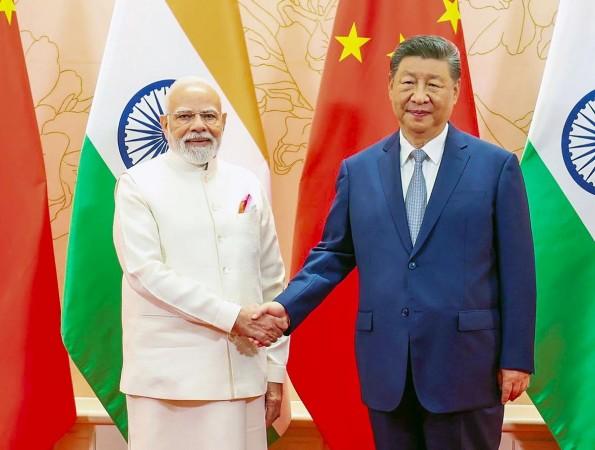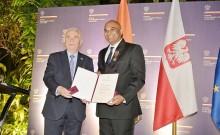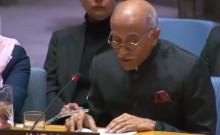
In the gilded halls of Kazan's BRICS Summit on October 23, 2025, Indian Prime Minister Narendra Modi and Chinese President Xi Jinping clasped hands for their first formal bilateral talks in five years, a handshake that thawed the frost of the 2020 Galwan clash and signaled a pragmatic pivot in Asia's dragon-elephant tango. As Reuters reports, the duo pledged to "boost communication and resolve conflicts," underscoring India's diplomatic dexterity in a tariff-tormented world where U.S. President Trump's 50% levies on New Delhi loom large.
This Kazan accord is no mere photo-op; it's a fulcrum for India's ascent, leveraging multi-alignment to eclipse China's scale with sustainable, inclusive momentum. Yet, as ties warm, the imperatives remain stark: fortify semiconductors, green infrastructure, and Global South alliances to turn thaw into triumph.
"In the India-China tango, today's steps toward trust could redefine Asia's economic rhythm for decades." —Alyssa Ayres, Former U.S. Deputy Assistant Secretary of State for South Asia
The Rising Elephant in a Multipolar World
India stands at a historic crossroads, poised to challenge China's economic and geopolitical dominance while carving a leadership role among global powers. As of October 2025, China's $19.23 trillion economy overshadows India's $4.19 trillion, yet India's projected 6.5% GDP growth outpaces China's 4.5%, signaling a dynamic shift. With a purchasing power parity GDP of $14.6 trillion, India ranks as the world's third-largest economy, steadily narrowing the gap with China's $40.7 trillion. The Kazan talks amplify India's strategic leverage, enabling it to balance BRICS advocacy with Quad security commitments, countering China's Belt and Road Initiative (BRI) while navigating U.S. tariff pressures.
This trajectory, fueled by demographic vitality, digital innovation, and diplomatic agility, positions India to potentially surpass China by 2040 and redefine the multipolar order. Hence the need to explore India's current standing, intrinsic strengths, transformative achievements, and the comprehensive imperatives required to eclipse China, outpace peers like the United States and European Union, and establish global leadership.
"India's rise is not just economic; it's a redefinition of global power dynamics, leveraging youth and innovation to challenge established giants." —Arvind Panagariya, Columbia University economist
Current Status: Momentum in a Shifting Landscape
India's economic ascent is a story of relentless progress against formidable odds. Since 2000, its GDP has surged from $468 billion to $4.19 trillion, driven by a vibrant services sector and an expanding manufacturing base under the "Make in India" initiative. This growth trajectory positions India to overtake Japan as the fourth-largest economy in 2025, a milestone underscoring its potential to close the gap with China, whose growth is slowing due to an aging population, real estate debt, and trade tensions with the West.
India's per capita GDP of $2,878 lags behind China's $13,687, but its PPP advantage and consistent 6-7% annual growth reflect a robust engine. Digitally, India's Unified Payments Interface processes $3 trillion annually, rivaling China's Digital Renminbi in innovation, though the e-rupee's $122 million circulation pales beside the e-CNY's $1 trillion. Geopolitically, the Kazan thaw builds on India's multi-alignment strategy balancing Quad, BRICS, and G20 leadership offering flexibility that China's assertive BRI lacks. Compared to the EU's sluggish 1.5% growth and Brazil's volatility, India shines, yet it trails the U.S.'s technological hegemony. The challenge is to convert this momentum into scale, positioning India as a global pacesetter.
"India's economic trajectory is a masterclass in resilience, but its challenge lies in scaling infrastructure and innovation to match its ambition." —Raghuram Rajan, former RBI Governor
Strengths: The Pillars of India's Potential
India's competitive edge rests on a unique confluence of demographic, institutional, and strategic assets that position it to outmaneuver China and rival global powers. Its youthful population, with a median age of 28 compared to China's 39, offers a demographic dividend peaking in 2040, capable of adding $1.5 trillion to GDP through a 1.4 billion-strong labor force. Institutionally, India's democratic framework fosters a vibrant innovation ecosystem, with 1 million AI professionals and the world's third-largest startup scene, boasting 100,000 startups generating $150 billion in value. English proficiency and an 18-million diaspora remitting $100 billion annually amplify soft power, drawing $81 billion in foreign direct investment in 2024, particularly in tech and renewables.
Sectorally, India leads in cost-competitive solar (74 GW capacity, doubling in 2025) and pharmaceuticals (20% of global generics), positioning it as a trusted alternative in a decoupling world. Diplomatically, the Kazan accord exemplifies India's multi-alignment engaging Quad for security, BRICS for advocacy, and G20 for influence granting leverage that China's debt-heavy BRI cannot replicate, while $30 billion in African credit lines build goodwill where China faces backlash.
"India's demographic and digital strengths are unparalleled; the question is whether it can translate potential into sustained global leadership." —Shashi Tharoor, Indian parliamentarian and author
Achievements: A Legacy of Transformation
India's journey from 2000 to 2025 is a testament to audacious reinvention. Economic reforms like the Goods and Services Tax and bankruptcy code have streamlined business, elevating India's ease-of-doing-business rank from 130 in 2016 to 63, attracting $81 billion in FDI in 2024. The "Make in India" initiative has lured global giants like Apple and Tesla, with iPhone production reaching $14 billion in 2025, eroding China's supply chain dominance. Digitally, UPI's 15 billion monthly transactions underpin a $3 trillion payment ecosystem, while Aadhaar-enabled welfare transfers of $1.3 trillion have halved leakages, enhancing inclusion.
The e-rupee pilot, launched in 2022, achieved 1 million daily transactions by 2023, pioneering offline payments. Technologically, Chandrayaan-3's 2023 lunar south pole landing and Aditya's 2024 solar mission, on a $1.5 billion ISRO budget, outshine NASA's $25 billion Artemis in efficiency. The $10 billion India Semiconductor Mission has birthed Micron's Gujarat fab and Tata's Assam plant, challenging China's chip dominance. Diplomatically, Vaccine Maitri's 2.2 billion COVID doses to 100 countries consolidated India's "pharmacy of the world" status, while 13 free trade agreements boosted exports to $450 billion.
"India's achievements in space, digital payments, and global health diplomacy signal a nation ready to lead, not just follow." —Kiran Mazumdar-Shaw, Biocon founder
Future Imperatives: A Blueprint for Global Leadership
To eclipse China by 2040 when India's PPP GDP could match China's current $40.7 trillion and lead the multipolar world, India must execute a transformative strategy across economic, technological, societal, and diplomatic domains.
Economic Transformation
India's $1.5 trillion infrastructure gap by 2030 demands $1.4 trillion in annual investments to rival China's 90,000 km rail network and 5G saturation. Scaling the $120 billion National Infrastructure Pipeline through green bonds, pension funds, and full FDI liberalization in rail, ports, and logistics is critical. High-speed rail corridors like Ahmedabad-Mumbai and nationwide 5G connectivity for 1.2 billion users by 2027 will drive productivity. Labor market reforms must formalize 200 million of the 90% informal workforce, boosting per-worker output from $7,000 to China's $28,000. Expanding Production-Linked Incentive schemes ($26 billion allocated) to achieve 25% of global manufacturing share by 2035 requires quadrupling semiconductor capacity and attracting giants like TSMC. In the green economy, scaling solar to 500 GW by 2030 and capturing $500 billion in exports will counter EU carbon taxes and China's renewable lead, while hydrogen and EV ecosystems target 20% global market share.
"India's infrastructure and manufacturing push must be relentless to match China's scale and compete in a decarbonizing world." —Nitin Gadkari, Indian Minister for Road Transport
Technological Sovereignty
India's R&D spending, at 0.7% of GDP, must double to 1.5% ($60 billion) by 2030 to rival China's 2.4%. Establishing public-private R&D hubs in Bengaluru and Hyderabad for quantum computing, 6G, and AI will challenge Silicon Valley's dominance. The $10 billion India Semiconductor Mission must expand to $50 billion, building 10+ fabs by 2030 to dent China's 75% East Asian chip share, with partnerships like TSMC and Intel critical. Scaling the e-rupee to $1 trillion in circulation by 2030 through UPI integration and cross-border pilots with Singapore and UAE will counter China's e-CNY and U.S. stablecoins. Leading in ethical AI frameworks, with 1 million professionals, requires enforcing the 2023 Data Protection Act and fostering 100,000 new startups to drive a $1 trillion digital economy.
"India's digital and semiconductor ambitions could redefine global tech, but only with bold R&D and global partnerships." —Sundar Pichai, Google CEO
Societal Cohesion
With only 50% of youth employable, reforming 1,000 universities and scaling IITs/IIMs to train 10 million in STEM by 2030 is paramount to outpace China's rote-learning model. Vocational programs aligned with Industry 4.0 AI, robotics, green tech will harness the demographic dividend. Inequality (Gini 0.35) risks unrest; $500 billion in Aadhaar-linked welfare transfers must target rural women and minorities, narrowing the 40% urban-rural income gap. Universal healthcare covering 1.4 billion by 2035 will boost productivity, avoiding China's $9 trillion urban debt trap. Urbanization, with 600 million city dwellers by 2030, demands 100 smart cities with AI-driven governance.
"India's youth and inclusivity are its greatest assets; skilling and equity will determine its global edge." —Amartya Sen, Nobel laureate economist
Diplomatic and Geopolitical Mastery
The Kazan accord underscores the need to deepen multi-alignment: expanding iCET with the U.S. for AI/quantum co-development, securing EU FTAs for green tech, and quadrupling $10 billion ASEAN investments to rival BRI's $1 trillion network. The India-Middle East-Europe Corridor (IMEC) must counter BRI's reach, while $50 billion in African credit lines emphasize capacity-building over China's debt traps. Quad naval exercises in 2025 should deter China's South China Sea assertiveness, while G20 advocacy on digital taxes and BIS reforms for CBDC interoperability position India as a rule-shaper. Mitigating cyber threats and U.S. protectionism requires $5 billion in cybersecurity and diversified FTAs with Africa and ASEAN.
"India's diplomatic agility is its trump card; leading the Global South while partnering with the West will shape the multipolar era." —S. Jaishankar, Indian External Affairs Minister
The Elephant's Epoch
India's quest to surpass China is a clarion call for reinvention in a multipolar world. Its $383 billion GDP addition in 2025 trails China's $1.26 trillion, yet the Kazan thaw amplifies its youthful vigor, digital prowess, and diplomatic finesse. Achievements in UPI, space exploration, and global health diplomacy showcase a model of inclusive innovation, while imperatives in infrastructure, technology, societal equity, and geopolitics demand unwavering execution. By 2040, India's economy could rival China's current scale, redefining global leadership with sustainable, equitable growth. As the elephant stirs, the world awaits its roar a beacon of possibility in a fractured global order.
"India's Kazan moment isn't just diplomacy; it's a declaration of intent to lead the Asian Century." -C. Raja Mohan, Indian strategic affairs expert.
[Major General Dr Dilawar Singh is an Indian Army veteran who has led the Indian Army's Financial Management, training and research divisions introducing numerous initiatives therein. He is the Senior Vice President of the Global Economist Forum AO ECOSOC, United Nations and The Co President of the Global Development Bank.]

















